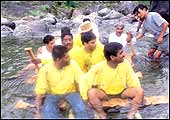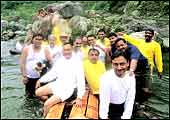|
|
|
Raiders Inc.: The "forward"
team en route the final destination strategises its next move
|
|
BOOKEND
|
This
is it," I remember my frantic mind screaming to me as I fell
off my sham-of-a-raft and started sinking like a stone in the ice-cold
waters of river Pala. I don't remember how long I lay under water
on the rock-spiked sandbed of the river, but the hand that finally
dragged me back up seemed forever in coming. I also don't know if
it was a nasty joke that my editor was trying to pull on me when
he nominated me to participate in a three-day reality learning programme
conducted by the National Institute of Sales (NIS) for a cement
manufacturer, but this certainly wasn't my idea of a joke.
You see, I am the kind of guy who'd rather
curl up in a sofa reading a Marquez, with a glass of Macallan rather
than schlep some 1,400 kilometres (fine, by air) only to get myself
killed. Besides, I had always thought that these reality learning
programmes were a bit of a sham-instead of picking up any vital
lessons in management, you only came back with a waist a few inches
bigger. In fact, I had smiled wickedly to myself when just two days
before I set off on the "expedition", NIS' Sanjeev Duggal
told me that it was a different kind of a training programme because
it would "push my mind and body". But second day into
the programme on the rain-lashed slopes of Darjeeling, just 60 miles
away from the snow-capped mountain of Kanchenjunga, I was beginning
to see adventure-based learning with new respect. After all, it
was team work that saved my skin.
|
ADVENTURE ON PALA
|
|
|
| Will This Thing Float?: That's the question
Mitra (first right) seems to be asking himself, hands akimbo |
 |
| Splash!: Mitra moments before he fell
off the raft and into the ice-cold Pala waters |
 |
| Hurray!: Moments after Mitra has been
fished out of the river, the team strikes a winning pose |
Day One
My 16 companions from the cement company reached
Darjeeling on the morning of June 20 via the Siliguri foothills
from Kolkata, and I joined the pack the same evening, winding my
way up the steep and narrow 81-km macadamised road that links the
hill station to Siliguri. By the time I checked in at Hotel Sinclairs,
the Lost Dutchman's Gold Mine-a simulation exercise where participants
are supposed to "maximise the returns on investment"-was
underway. It was raining outside as I made my way to the conference
room, where the two trainers-Captain Shantanu Chakravorty and Nilanko
Chatterjee-and the participants were already an hour into LDGM.
The indoor exercise had the 16 participants
break up into teams of four (being a late-comer I wasn't part of
any), where each team was handed a resource pack that would help
them "mine gold" in a virtual landscape. The trainers,
on their part, heightened the difficulty level by simulating hostile
weather conditions that changed every two minutes, and the participants
were ranked on "accuracy, timeliness and completeness".
(Sadly, the group could only mine half of the $60,000 worth of gold
available.)
LDGM was followed by an exercise that sought
to help participants document the obstacles they were facing, if
at all, within their organisation. The group of 16 was split equally
into two and both were given two big flip charts on which they were
to list their workplace obstacles. Issues top of the charts: communication,
resource utilisation, dead stocks, inventory management.
Day Two
The 17 of us lined up the next morning for
something NIS dubs able (adventure-based learning experience). We
were herded into three Jeeps and taken 54 km from Darjeeling to
Bhalukhop (bear's cove in Nepalese), near the orchid town of Kalimpong.
Here we were introduced to Dhrubo Kumar Gurung, a former chief flight
instructor in the Army. In Gurung's classroom, Chakravorty took
us through the training module, designed on military simulation.
Handing us maps, compasses, wireless sets, bush hats and numbered
T-shirts, the captain explained what we were about to embark upon.
Our task was to build two ordnance factories.
Before any of us could say cakewalk, Chakravorty
pulled out a rough map that resembled a flying saucer, where he
marked off the top half as Red Land and the bottom, Blue Land. Then,
he laid out the scenario in which we were to build the ammunition
factories. Red Land is waging a guerrilla war in Blue Land, which
has decided to plug the problem by building two ordnance factories
on the common border. "There is a major water body (river Pala)
that criss-crosses the road and is littered with mines," points
out Chakravorty, as some of us thank god that this is only a simulation.
|
|
|
Cross-Currents: The picture makes crossing
a river seem so easy. It's anything but that
|
The briefing over, we were given half-an-hour
to come up with our operation nomenclature and organise ourselves
into forward and command teams. Needless to say, senior managers
in the team got into the act and came up with "Operation Giant"
as we grouped ourselves into two teams: 10 forward and seven command
members. The role assigned to me was that of the mine-watcher, who
must lead and inform the de-mining officer whenever a mine is spotted.
From the starting point, all the 17 of us had
to reach a designated command post (we were handed four photographs
to lead us there) littered with mines. We reached the first post
without any mines blowing up. But I obviously wasn't keeping a sharp
eye out on the second leg of the trip, because I heard a blast right
behind us. Again I thanked god it was only a game. My fellow miner
messed up the next time, missing a mine kept sideways. We were blasted
for the second time. "Bloodied" and possibly a "few
men down", we reached the command post, from whereon it was
the job of the forward team to make it to the final destination
using directions from the command team. Navigation and communication
skills were tested to the hilt and home run seemed highly improbable.
But the 10 of us in the forward team braved the elements and somehow
reached a green hut perched atop a hill-the finishing line. Time
taken: 47 minutes to cover a 1 km stretch.
The game wasn't over yet. We now had to guide
the command team, which had the pictures but no clue about the lay
of the land. It took us three-quarters of an hour to guide the eight-member
command team home. After a short lunch break, we were off again-to
engineer our own rafts and test them on the churning waters of Pala.
You already know what happened to yours truly on these treacherous
waters. Our adventure on Pala ended with me being fished out of
the cold river and the teams heading back to Darjeeling. That night
I slept like I never had.
|
|
|
Man In Black: Capt. S. Chakravorty
(in black tee) briefing the team ahead of an exercise
|
Day Three
The first half of our final day in Darjeeling
was spent rock climbing at the Himalayan Mountaineering Institute.
I saw some of the intangible qualities of good management (self-motivation
and pride) come into play as men in their 30s to 50s variously had
a go at the 20-ft artificial rock face. As for me, I was the last
to play Spiderman, with no Mary Jane Watson to fall back on. Never
mind, I managed in a record 53 seconds.
Once the climb was through, we went back to
the hotel and into the conference room. From an active participant,
I became an observer again because the flip charts from the first
day's evening session were the subject of discussion. I found out
that the flip charts had since been worked upon by the trainers
and turned into a solid action planning (SAP)-a process where all
the obstacles are addressed individually and possible solutions
logged, with timeliness. NIS, I later learnt, compiles a study of
all the groups that have undergone such a training, and sends a
post-training report to the respective companies. Going by my experience,
I am sure it works. Especially if-like me-you return feeling lucky
to be alive.
|
TREADMILL
|
| Get Intense To Get Big
Everyone faces this problem.
You're woefully short of time and yet you don't want to miss
your workout. The simple solution: compromise. Cut down your
exercises, skip the cardio, don't do too many reps, etc. But
do you know that squeezing in a 15 minute high intensity workout
can actually help you build muscles and strength? Cutting
down intervals between sets actually helps stimulate release
of growth hormones.
If you have just 15 minutes a day for weight training, here's
how you can make the most of it. I call it the "short
interval, descending reps combo". Here's what it is.
It's two groups of exercises. Let's call them Group A and
Group B. In each of them you have two kinds of exercises.
Let's take Group A. It has the flat bench press and the regular
free-weight squat. And Group B? The underhand chin up (or
the overhand pull-up, which is tougher) and the classic deadlift.
Here's how they work. Do Group A and B on alternate days.
And do them as follows. First, begin with, say, the bench
press. Use about 50-60 per cent of the weight you can use
to do 10 reps. Begin with a set of 10 reps. Pause 10 seconds
and do a set of 9. Pause 10 seconds and do a set of 8. And
so on till you do the last set with one rep. Take a minute's
rest. Switch to squats. And do the same thing. A 10-rep set.
Ten second pause. A nine-rep set. Ten second pause... and
so on. That's it. You're done for the day. The next day, do
group B. Start with chin-ups and then move on to deadlifts.
The only thing. For chin-ups, unless you're superstrong, start
with a five rep set and go down to one.
Each group can be done in 15 minutes. I'd suggest complementing
each group with a high intensity cardio session, say, a 10-minute
power walk on the treadmill. So that in less than half-an-hour,
you have a balanced workout. If you have access to a gym during
your workday, this is a great schedule to follow.
Tip of the fortnight: Eat four to five small meals, spaced
through the day, instead of gorging at dinner or at lunch.
And try to give your self at least two hours between your
last meal of the day and bedtime.
-MUSCLES MANI
|
|

